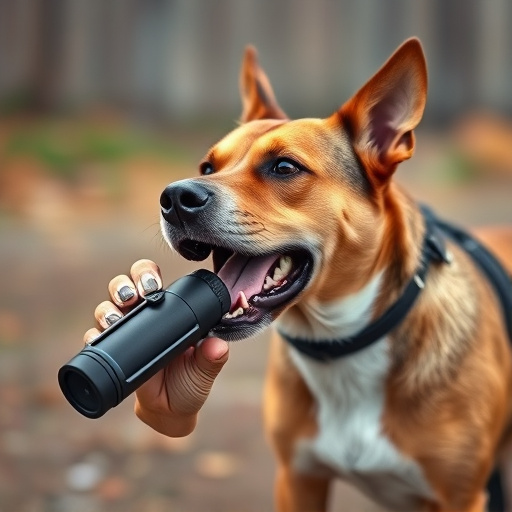Pepper spray (capsaicin) temporarily disables aggressive dogs but should be used as a last resort. Immediate decontamination after exposure is crucial, involving rinsing eyes with water or saline and gentle cleaning. Vet-approved procedures should address varying dog sensitivities. Always wear protective gear when handling pepper spray and store it safely to ensure effectiveness. In case of pet exposure, rinse affected areas for 15+ minutes and seek vet care for severe symptoms.
“Confronting aggressive dog behavior can be daunting, but understanding effective deterrents like pepper spray is crucial. This guide explores how pepper spray can temporarily incapacitate and desensitize dogs, offering a safe alternative to extreme measures. We’ll delve into its application techniques, focusing on when and how to use it responsibly. Additionally, learn essential decontamination methods for pets exposed to pepper spray, ensuring their well-being post-interaction. Discover best practices for storage and handling to keep your family and pets safe.”
- Understanding Pepper Spray and Its Effects on Dogs
- When and How to Use Pepper Spray on Aggressive Dogs
- Decontaminating Your Pet After Pepper Spray Exposure
- Safe Handling and Storage Practices for Pepper Spray
Understanding Pepper Spray and Its Effects on Dogs
Pepper spray, also known as capsaicin, is a natural compound derived from chili peppers. When used on dogs, it acts as a powerful irritant to their eyes and respiratory system. The effects are designed to temporarily incapacitate the animal, giving handlers or owners time to secure or move the dog safely. However, it’s crucial to understand that pepper spray is not a long-term solution for aggressive behavior; rather, it should be used as an emergency tool during potentially dangerous encounters.
After a dog is exposed to pepper spray, proper decontaminations steps are essential. This includes rinsing the eyes thoroughly with water or a mild saline solution to dilute and flush out any remaining spray. The area should be gently cleaned, and the dog should be monitored for discomfort or respiratory distress. It’s important to have vet-approved decontamination procedures readily available, as the severity of reactions can vary based on individual dog sensitivity and the amount of exposure.
When and How to Use Pepper Spray on Aggressive Dogs
When faced with an aggressive dog, knowing how and when to deploy pepper spray can be a life-saving skill. It’s crucial to use it as a last resort when all other calming methods have failed, for the safety of both your pet and the potential threat. Before applying, ensure the area is well-ventilated to minimize inhalation risks not just for you but also for the dog. Aim for the face and eyes, as these areas are highly sensitive, temporarily blinding and disorienting the animal without causing lasting harm.
After successfully deterring an aggressive dog with pepper spray, decontaminating your pet becomes a priority. This involves thoroughly washing their face, paws, and any fur they may have licked to prevent them from ingesting capsaicin, the active ingredient in pepper spray. Rinse with cold water and use a mild soap if available. It’s important to monitor the dog for any adverse reactions and seek veterinary attention if needed.
Decontaminating Your Pet After Pepper Spray Exposure
After your pet has been exposed to pepper spray, decontaminating them is crucial for their safety and well-being. Start by removing any contaminated clothing or bedding immediately. Rinse the affected areas thoroughly with water, ensuring no residue remains. This step is vital in preventing further irritation or potential damage caused by the chemical agents in pepper spray.
For dogs, gently wipe down their fur using a mild, fragrance-free shampoo, focusing on the areas where the spray made contact. Be sure to rinse the shampoo away completely. If your pet’s eyes or nose were exposed, seek veterinary care promptly. Additionally, ensure they have access to clean water to drink and avoid any strenuous activities until they are fully recovered.
Safe Handling and Storage Practices for Pepper Spray
When handling pepper spray for aggressive dogs, safety is paramount. Always wear protective gear, including gloves and eye protection, to avoid direct contact with the spray. Ensure proper ventilation in the area where the spray is stored or used to minimize inhalation risks. Keep the container tightly closed when not in use, and store it in a secure location out of reach of children and pets.
For any pet that has been exposed to pepper spray, immediate decontamination is essential. Rinse the affected area thoroughly with water for at least 15 minutes, ensuring all remnants of the spray are removed. If the exposure was severe or the animal shows signs of distress, seek veterinary assistance promptly. Regularly cleaning and storing the pepper spray according to manufacturer guidelines will help maintain its effectiveness and ensure it remains a safe tool for managing aggressive canine behavior.
Pepper spray can be a useful tool in managing aggressive dog behavior, but it should only be used as a last resort. After any exposure, it’s crucial to follow proper decontaminating procedures for your pet, such as rinsing the affected areas thoroughly with warm water and soothing shampoo. Always store pepper spray safely out of reach and dispose of it responsibly. Remember, while effective, pepper spray is not a cure-all; consistent training and behavior modification remain key components in addressing aggressive dog issues.
